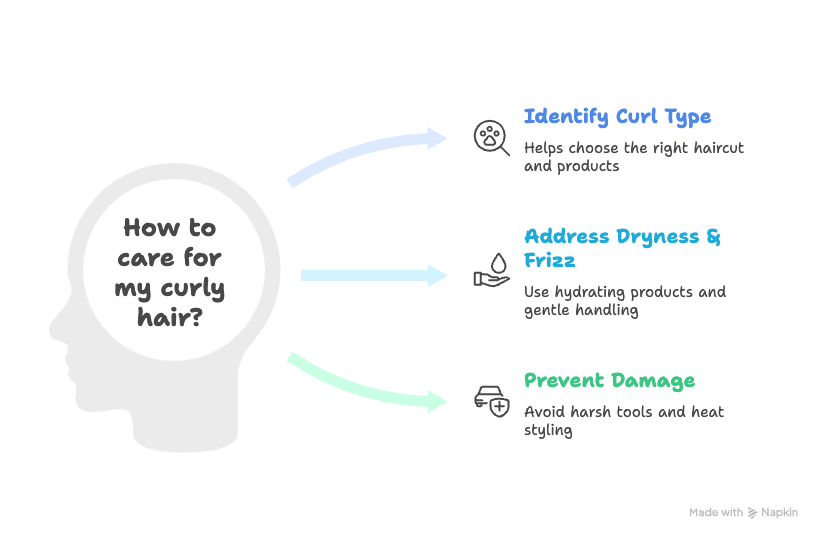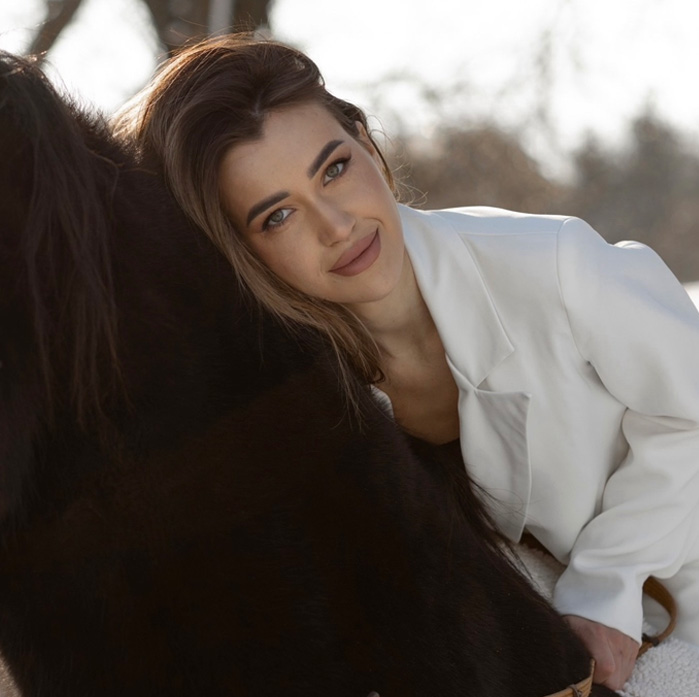Curly hair Styles offer a unique look that can be styled in many ways to suit different occasions and personal styles. Understanding how to work with natural curls rather than against them is key to achieving flattering and manageable hairstyles. The best hairstyles for curly hair enhance its natural texture, frame the face well, and make daily styling easier.


Many haircut options and styling techniques suit different curl types, from loose waves to tight coils. Selecting the right length, layers, and accessories can make curls look defined and healthy without excessive volume or frizz.
With some simple tips and the right products, anyone with curly hair can enjoy hairstyles that celebrate their curls and make them feel confident every day.
Key Takeways
- Natural curl texture should be embraced and enhanced for the best results.
- Different curl patterns need specific haircuts and styling approaches.
- Proper care and products help maintain curl shape and reduce frizz.
Understanding Curly Hair
Curly hair varies greatly in texture, pattern, and care needs. Knowing the type of curls and the challenges they face helps in managing and styling them effectively. Embracing natural curls offers both aesthetic and practical benefits.
Identifying Your Curl Type


Curly hair covers a range of textures, from loose waves to tight ringlets. Curl types are usually classified in a system numbered 2 to 4, with subcategories A, B, and C.
- Wavy: S-shaped waves, usually fine to coarse.
- Curly: Defined spirals or ringlets with varying tightness.
- Coily or Kinky: Very tight curls or zigzag patterns.
Identifying curl type helps in choosing the right haircut and haircare Identifying your curl type helps you choose the right haircut and haircare products. Looser waves require lighter hydrating products, while tighter curls benefit from thicker moisturizers. Knowing the curl pattern allows you to style your hair to enhance its natural texture without causing frizz or damage. Looser waves need lighter hydrating products; tighter curls benefit from heavier moisturizers. Knowing the curl pattern leads to styles that enhance natural texture without adding frizz or damage.

Unique Challenges of Curly Hair
Curly hair often suffers dryness, frizz, and breakage because its shape blocks sebum from traveling down the hair shaft, leading to dryness, brittleness, and split ends.
Tangles and knots often occur due to hair shape. Curly hair is more prone to environmental damage from humidity and heat styling, causing increased frizz and potential damage.
Care routines should include hydration, gentle handling, and frequent trims. Avoiding harsh brushes and heat tools helps maintain the hair’s natural health. Proper care ensures curls stay defined and manageable.

Benefits of Embracing Natural Curls
Embracing natural curls reveals unique texture and volume not found in straight hair. Natural curls offer versatility in styling, from voluminous ringlets to soft waves.
Wearing hair naturally reduces reliance on heat tools and chemical straighteners, which can damage hair over time. It can save time and effort in daily styling while promoting healthier hair. Embracing curls supports a natural, personalized look that highlights individuality.
Best Haircuts for Curly Hair
Curly hair has unique needs that vary by length and shape. Choosing the right haircut can make curls easier to manage, enhance natural volume, and create a balanced look. Key styles for curly hair include variations of the bob, pixie cuts, shag hairstyles, and lobs, each offering different ways to work with curl patterns and face shapes.


Curly Bob Variations
The curly bob offers a mix of structure and bounce that suits many face shapes. It usually hits around the jawline, creating volume without overwhelming the features.
A luxe bob with medium curls features clean lines for a polished look suitable for casual or special events.
Layers in a curly bob reduce bulk, prevent heavy or tight curls. Some choose a rounded shape to soften square faces, while others add soft layers to frame the face lightly. Suitable for medium to tight curls, it’s low-maintenance.
Curly Pixie and Pixie Cut Options
The curly pixie cut is a very short style that emphasizes texture and facial features. It provides a crisp, clean look, making it a practical choice for those with active lifestyles. This cut requires less daily styling and can be worn tousled for casual looks or more defined for formal settings.
Curly pixies work best with small, tight curls, allowing the hair’s natural volume to come forward without needing much shaping. Soft layers can add movement and prevent the haircut from appearing too flat. The pixie is a timeless choice that blends style with convenience.


Curly Shag Styles
The curly shag is characterized by plenty of layers that create volume and a natural flow. This style works well with various curl sizes, from waves to tighter spirals, giving hair a lively and dynamic appearance. The multiple layers prevent curls from clumping and boost natural movement.
This relaxed haircut lets curls stay free, perfect for low-maintenance yet trendy styles.
Layers around the face can add softness and shape, balancing facial contours. The shag suits both casual and formal looks by simply adjusting the styling.
Lob for Curly Hair
The lobâ—a longer bobâ—fits curly hair, combining length with shape.
It usually falls around the shoulders and includes layers that help control volume and add gentle bounce.
It’s great for loose curls or soft waves, providing a smooth, flowing look.
Layers in a lob provide flexibility to style hair either sleek or natural. This cut can elongate round faces and soften strong jawlines, adapting easily to different hair textures. It suits those who want a modern, versatile haircut that is easy to manage while keeping length.


Popular and Easy Hairstyles for Curly Hair
Curly hair offers a lot of styling options that are both stylish and easy to achieve. Some hairstyles focus on embracing natural texture, while others use simple techniques to create polished looks. These styles work well for everyday wear or special occasions and require minimal effort to maintain throughout the day.
Messy Bun Looks
The messy bun is a practical choice for people with curly hair. It helps control volume and keeps curls out of the face without losing their natural bounce. To create this look, gather curls loosely at the crown or nape and secure with a hair tie or bobby pins.
The key to a good messy bun is allowing some curls to fall naturally. This keeps the style relaxed and adds texture.
This style suits relaxed days or quick fixes and protects curls from damage from over-brushing or heat, keeping them healthy and beautiful.


Curly Updo Inspirations
Curly updos provide an elegant way to showcase natural texture while keeping hair controlled. Styles like loose buns, twisted pinned curls, or simple roll-ups maintain volume without flattening curls.
To start, moist curls are best. Applying a curl cream helps shape and hold. Hair can be gathered halfway up or fully pulled into a bun, with some strands left loose around the face for softness.
These updos are heat-free, making them gentler on curls. Use bobby pins to secure the hair and flexible hairspray to keep the style intact while allowing natural movement. These updos suit formal occasions and add a romantic, effortless feel to curly hair.
Slicked-Back Low Ponytail
A slicked-back low ponytail balances neatness and texture. It holds curls smoothly along the scalp while letting them spring freely in the ponytail. This style works best on dry hair treated with smoothing gel or cream.
To achieve this look, brush hair back with a boar bristle brush or fingers, then secure at the nape. The ponytail can be tight or loose. Gel tames flyaways and creates a sleek finish without weighing curls down.
This ponytail style offers a polished look for work or events, highlighting natural curl patterns and being low-maintenance for quick redo after washing.


Half-Up Styles and Top Knots
Half-up hairstyles provide versatility by combining loose curls with controlled sections. Pulling the top half of hair into a bun adds shape, with curls flowing below.
A common technique is to gather hair from the crown and twist it into a small bun, secured with a clip or elastic. This keeps hair off the face and emphasizes volume on top.
Using light styling products defines curls and prevents frizz. The half-up look suits all hair lengths, fitting casual or formal events and adding dimension to curly styles.
Creative Curly Hair Styling Ideas
Curly hair offers many ways to express style through creative detailing. Adding accessories, braids, and twists can enhance texture and create unique looks without heavy styling tools. These simple techniques add charm and structure to natural curls.
Scarf Braid and Woven Styles


Using a scarf with curly hair adds color and protects curls from frizz. Common styles include weaving it into a braid along the hairline or incorporating it into a half-up style.
To create a scarf braid, the wearer wraps the fabric around sections of hair and then braids, making sure the scarf is tight enough to stay secure but loose enough to avoid pulling.
The finished look blends the softness of curls with a bold, colorful accent.
Woven styles let curls peek through, and the scarf adds pattern and texture.
This approach works well for casual or dressy looks. Scarves made of silk or lightweight cotton are best to prevent damage.
Accent Braids and Fishtails
Accent braids are narrow, small braids added to specific sections of curly hair. They add detail without needing to alter the entire hairstyle. These braids can frame the face, lift hair off the forehead, or run along the scalp.
The fishtail braid is truly eye-catching with its intricate, overlapping pattern that adds a charming touch to any look. To create it, you divide your hair into two sections and gently cross small pieces over from one side to the other.
A fishtail braid really enhances the natural volume of curly hair, making it look wonderful.
Both accent braids and fishtails hold well in curly hair due to their natural grip. They can be worn alone or combined with loose curls for a balanced style.
Bobby Pin and Clip Details


Bobby pins and clips are practical tools to control curls while adding subtle style. Positioning decorative pins in curved or angular patterns creates interest.
Popular ways to use pins include pushing hair back at the temples or securing small twists and braids. Clips with pearls, rhinestones, or geometric shapes contrast nicely with curly texture and add a polished finish.
For hold, it helps to lightly mist hair with styling product before pinning. This keeps curls defined and prevents slipping. The versatility of pins means they can suit both everyday looks and special occasions.
Styling Tips and Product Recommendations
Curly hair styles thrive on the right balance of moisture, definition, and gentle care. Choosing suitable products and techniques helps keep curls crisp and voluminous without dryness or frizz.
Using Curl Cream and Curl-Defining Cream

These products smooth the hair cuticle, reduce frizz, and encourage natural curl patterns.
Applying curl cream to soaking-wet hair yields better results. Use the “praying hands” method- flatten the product between the palms and gently press through the hair without disturbing the curl shape. This technique locks in moisture and separates strands.
Most curl creams offer lightweight hold and shine without stiffness. For stronger hold, curl-defining creams often combine hydration with hold agents that keep curls bouncy yet soft. Using about a quarter-sized amount evenly throughout the hair is usually enough.
Maintaining Definition and Volume
Maintaining curl definition requires gentle handling to avoid breakage.
Using a wide-tooth comb or detangling brush on wet, conditioned hair helps prevent knots and damage.
Drying your curls carefully helps boost their natural volume by evenly distributing heat, minimizing frizz and resulting in beautifully consistent curls.
Gently scrunching hair with a microfiber towel or cotton T-shirt beforehand enhances volume without damaging the cuticle.
Touch-ups with a curling wand can refresh limp curls. Selecting a barrel size close to the natural curl diameter is best for blending and reshaping individual curls without redoing the entire head.


Protective Styling for Curly Hair
Protective styles reduce manipulation and protect curls from daily wear. Braids, twists, buns, and topknots keep curls contained and less exposed to friction, preventing breakage.
Using silk or satin scrunchies prevents hair creasing and damage versus elastic bands. Sleeping on a silk pillowcase reduces friction and preserves curl shape overnight.
Light moisturizing sprays or leave-in conditioners can be applied between washes to revive curls without buildup. Protective styles paired with regular hydration maintain hair health and extend style longevity.
Hairstyles for Curly Bangs and Face-Framing Layers
Face-framing layers can really boost your hair’s volume and bounce, bringing out the beautiful curl texture.
Balancing bangs, layers, and part placement highlights facial features and keeps curls manageable.


Curly Bangs Styling Tips
Curly bangs require careful trimming to avoid extra bulk near the forehead.
Heavier bangs tend to complement looser curls beautifully, giving a relaxed and balanced look.
Moisturize your bangs with a light curl cream to keep them soft and defined.
Drying bangs with a diffuser reduces frizz and preserves bounce. Trim every 4-6 weeks to prevent uneven growth that can disrupt style.
Layered Cuts for Bounce
Layers added around the face lift the curls, creating natural volume and movement. Cutting in graduated layers prevents the hair from looking heavy or flat.
Longer layers soften the silhouette and help curls fall freely without being weighed down. Shorter layers near the face add shape and emphasize cheekbones and jawline.
Proper layering encourages curls to spring up, resulting in a lively, full-bodied look. Stylists often recommend layering based on curl tightness to maintain balance between volume and definition.


Side Part and Volume Placement
A side part can drastically change how curls frame the face. Placing the part to one side lifts the hair at the roots, adding height and volume.
For round or oval faces, a deep side part combined with face-framing curls softens the profile and highlights key features like eyes and cheekbones.
The volume created near the part brings a polished look without compromising natural curl texture. Adjusting the side part allows for versatile styling options, from casual to formal.
How should I care for my curly hair to prevent dryness and breakage?
Proper care involves regular hydration using leave-in conditioners or moisturizing sprays, gentle handling with wide-tooth combs, avoiding excessive heat styling, and routine trims to remove split ends, which all help prevent dryness and breakage.
What are some popular and stylish hairstyles I can try with curly hair?
Popular hairstyles include messy buns, slicked-back ponytails, half-up styles, curly updos, and creative styles using accessories, braids, or twists that are easy to achieve and maintain for daily or special occasions.
How can I protect my curly hair during sleep and outdoor activities?
Protective measures include using silk or satin pillowcases or hair coverings, styling hair in braids or buns before bed, and avoiding friction and harsh environmental exposure, which helps preserve curl integrity and reduces damage.
- 45shares
- Facebook0
- Pinterest45
- Twitter0



